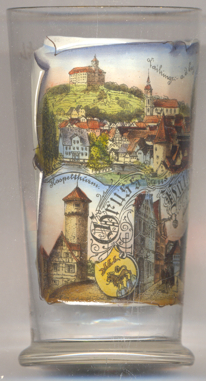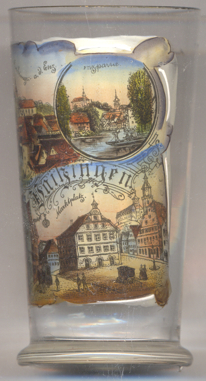

|
| DEUTSCHLAND | GERMANY |
| Bundesland: Baden-Württemberg | Rhineland-Palatinate |
| Regierungsbezirk: Stuttgart | |
| Landkreis: Ludwigsburg |
Vaihingen an der Enz is situated at an elevation of 217 m an the river Enz in the district Ludwigsburg, about 24 km northwest of Stuttgart. The municipality has a population of about 29,000 (2016).
Vaihingen may date back as far as 799 AD in a deed of donation for the monastery at Fulda, but
it is unclear whether this refered to Vaihingen an der Enz or rather to a another place near Schwieberdingen called
Vöhingen (perished in the late Middle Ages). Riet, today part of Vaihingen, was first mentioned in the Lorsch Codex
in 812. Vaihingen was founded around 1230 near Vainingen castle (itself mentioned already in 1096, today named Schloss
Kaltenstein). In 1252, Vaihingen was mentioned for the first time explicitely as a town. Later owned by the margraves of
Baden, town and castle were obtained in 1334 by the counts of Oettingen, and in 1339 by the
counts of Württemberg. The Reformation was introduced after 1534 and Vaihingen became the seat of a deanery. In 1693,
during the Palatinate War of Succession (1688–1697), Vainingen was destroyed almost completely by a large fire.
The railroad from Stuttgart to Bruchsal opened in 1853; however, the
station 'Vaihingen-Sersheim' was located about 3 km away and therefore Vaihingen could not profit from the
industrialisation period. This changed with the opening of the Vaihingen city railway in 1904. The former districts
('Oberämter') Vaihingen and Maulbronn were merged into the new district ('Landkreis') Vaihingen in 1938.
The district was dissolved in 1973; the western part was merged into the new Enzkreis district (with its capital
Pforzheim), the eastern part with Vaihingen became part of the district
Ludwigsburg. A new railway station ('Vaihingen (Enz)') was built in 1991 for the high-speed
railroad Mannheim–Stuttgart.


 Kaltenstein castle [top left picture: background left]
is the popular landmark of Vaihingen an der Enz. Castle Vehingen was first mentioned in 1096. In the 14th century
it came in possession of the margraves of Baden, the counts of Oettingen, and finally in 1339 the counts of Württemberg.
In the 16th century the inner part of the castle was rebuilt into a residence castle, and it was presumably then that
its name changed to Kaltenstein. Further modifications followed until the 18th century. Until the end of the 19th century
it served as garrison, military hospital and, since 1842, as workhouse. During the Nazi period, the castle was used as
a detention centre. From 1949 until 2013 it was used by the CJD (Christliches Jugenddorfwerk Deutschlands).
Kaltenstein castle [top left picture: background left]
is the popular landmark of Vaihingen an der Enz. Castle Vehingen was first mentioned in 1096. In the 14th century
it came in possession of the margraves of Baden, the counts of Oettingen, and finally in 1339 the counts of Württemberg.
In the 16th century the inner part of the castle was rebuilt into a residence castle, and it was presumably then that
its name changed to Kaltenstein. Further modifications followed until the 18th century. Until the end of the 19th century
it served as garrison, military hospital and, since 1842, as workhouse. During the Nazi period, the castle was used as
a detention centre. From 1949 until 2013 it was used by the CJD (Christliches Jugenddorfwerk Deutschlands).
The top right picture on glass no. 3401 is labeled 'Enzpartie' ('area at the river Enz').
The Protestant  town church [top left picture: background right]
was originally built in 1339 as a Lady chapel in Romanesque-Gothic style. Since 1449 it is known as 'church of Our Lady'.
The church was enlarged in 1513 but was destroyed by a large fire in 1618. The church was rebuilt but again was
destryoed by fire in 1693. The present church was built in 1697–1701.
town church [top left picture: background right]
was originally built in 1339 as a Lady chapel in Romanesque-Gothic style. Since 1449 it is known as 'church of Our Lady'.
The church was enlarged in 1513 but was destroyed by a large fire in 1618. The church was rebuilt but again was
destryoed by fire in 1693. The present church was built in 1697–1701.
The  Haspel Tower [bottom left picture], also named Thieves' Tower,
was built in the 15th century as part of the town's fortifications and served as a prison. The original reel (German:
Haspel), which was used to let down prisoners into the 8-metres-deep prison chamber, is still preserved.
Haspel Tower [bottom left picture], also named Thieves' Tower,
was built in the 15th century as part of the town's fortifications and served as a prison. The original reel (German:
Haspel), which was used to let down prisoners into the 8-metres-deep prison chamber, is still preserved.
The  town hall [bottom right picture] in the market square was built in
and after 1720 in place of the old town hall that had been destroye by the fire of 1693. The frescos on its façade
date from 1901. The windows received new leaded windows in 1951–1998.
town hall [bottom right picture] in the market square was built in
and after 1720 in place of the old town hall that had been destroye by the fire of 1693. The frescos on its façade
date from 1901. The windows received new leaded windows in 1951–1998.
[https://de.wikipedia.org/wiki/Vaihingen_an_der_Enz, https://en.wikipedia.org/wiki/Vaihingen_an_der_Enz;
https://de.wikipedia.org/wiki/Schloss_Kaltenstein]
![[scale]](lineal.jpg)